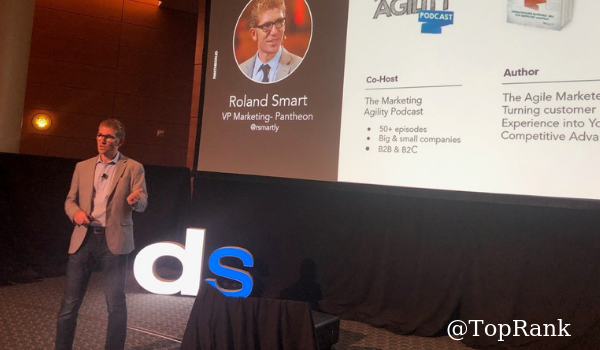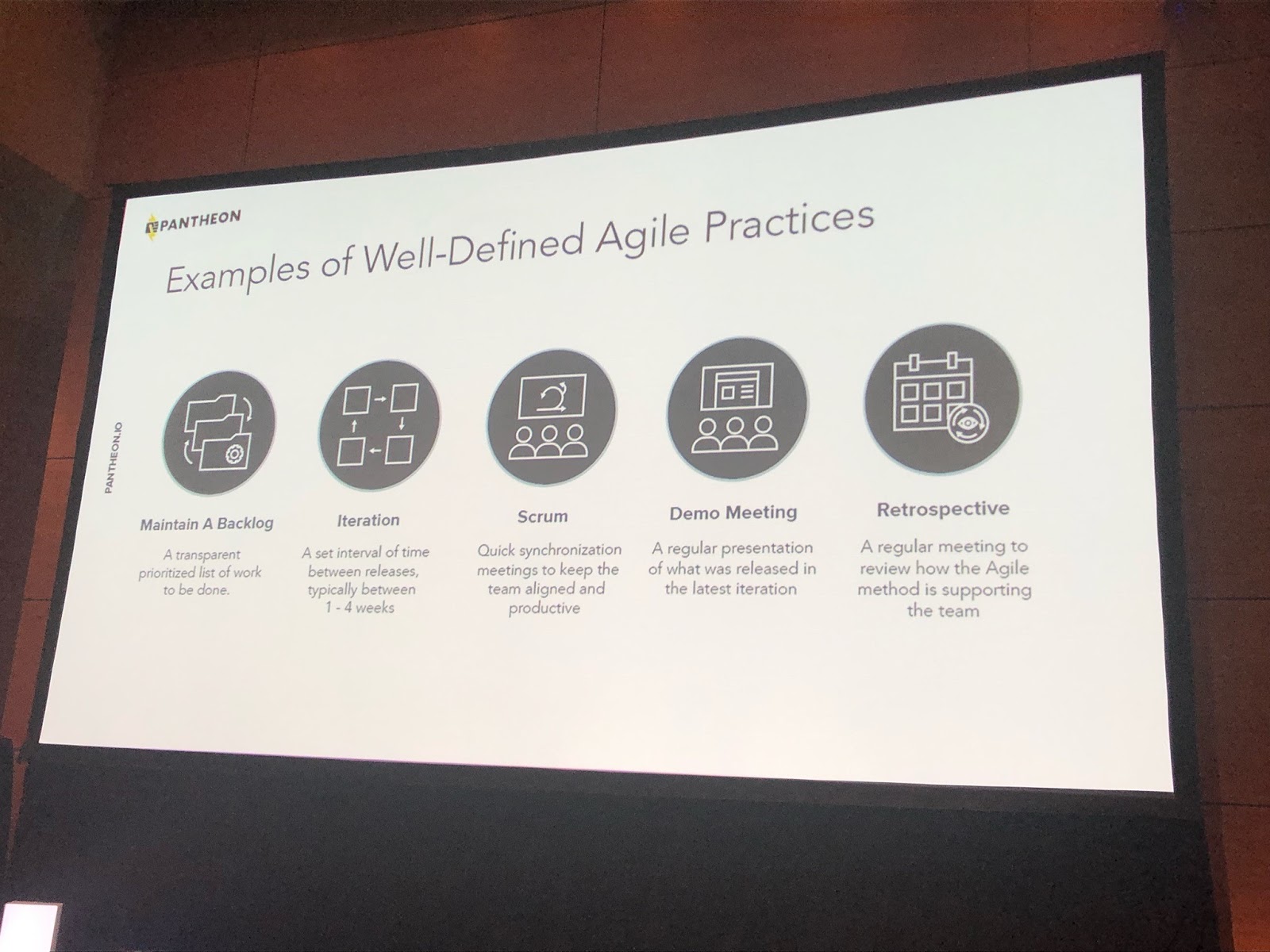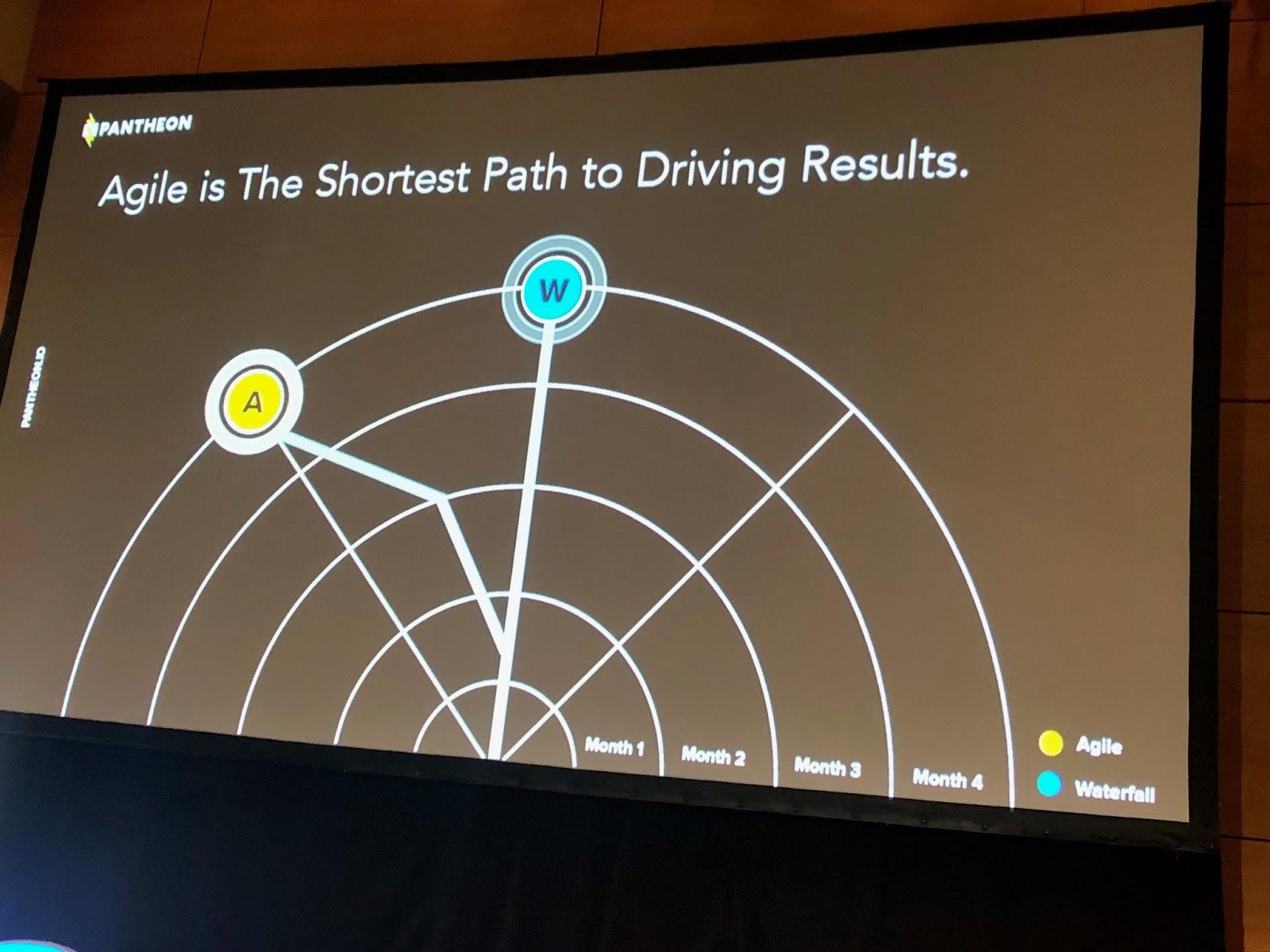
Run a Google search for “agile marketing” today and you’ll see 144 million results. It’s an insanely hot topic, which has steadily grown more applicable and desired from it’s “Scrum” beginnings.
Why are marketers today so obsessed with agility? Roland Smart, podcaster, author of “The Agile Marketer: Turning Customer Experience Into Your Competitive Advantage” and Vice President of Marketing for Pantheon*, shared his insight on the subject at Digital Summit Minneapolis this week.
For starters, the average marketer’s tenure is just 18 months. After all, we need to get results—and we need them fast. Second, while our strategies and tactics have been artfully crafted with insight and data, once we put everything into the wild, we need to be able to act fast to monitor, measure, and optimize performance—while also navigating budget and “waterfall” resourcing limitations and challenges. And finally, today’s marketers are often managing a growing tech stack, making an agile approach a match made in heaven.
Read on to learn more about agile marketing and Roland’s secrets to making agile marketing a reality in your organization.
What is Agile Marketing?
There are several different things that marketers think of when it comes to agile marketing. (Scrum and Kanban are two of the concepts that are likely top of mind.) But a simple definition is: Agile marketing is a methodology that enables marketers to meet the rising tide of challenges of customer experience in the digital era.
At the most basic level, an agile marketing approach means tackling your highest priority task, assessing success, optimizing until solved, and then moving to your second priority task. As it relates to general agile practices: “Scrum and Kanban are simply a collection of underlying practices that your team is going to do day-in and day-out as a part of your agile practice,” Roland explained.
While each team will have its own subtle variations of their agile practices, a solid framework for marketers trying to get started is:
- Maintain a Backlog
- Iterate
- Scrum
- Demonstrate
- Retrospective

How Can Marketers Benefit From Agile?
According to Roland: “Agile is the shortest path to driving results.”
#Agile is the shortest path to driving #marketing results. @rsmartly #DSMPLS Click To Tweet
In a traditional waterfall methodology, the output is exactly what is planned. But by using an agile methodology, thanks to frequent feedback loop with stakeholders and customers plus subsequent direction refinement, the output is what is needed to drive results.

The Secret to Agile Marketing Transformation
Test Before Advocating for a Transformation
Of course, completely transforming your marketing operations is a major undertaking. So, in the spirit of agile practices, marketers can dip a toe in the agile marketing waters, Roland said.
He suggested a simple exercise testing the “Growth Lever” for a “North Star Metric.”
First, identify a priority website metric like conversions; that’s your North Star Metric. In a waterfall method, you might dive in and optimize several of your form fields and your calls to action copy and design. But in this agile approach, you can select a single Growth Lever. This should be something on the website that you can change and measure that will ultimately impact your North Star Metric.
For example, you may simply change a single CTA copy. If you have the ability and traffic volume to set up the change as an A/B test, great. If not, you can reference your past performance as a benchmark.
Roland explained, “This [data from the] Growth Lever won’t move ‘the hour’, but you’ll see the minute hand moving and can learn from that.”
The bottom line? This can help you learn before you’ve invested a massive amount of time and resources.
Get Buy-In & Break Down Silos By Leveraging Your ‘Secret Weapon’
Getting buy-in and collaboration from stakeholders across the organization is key to the success of any initiative, and it’s no different for agile marketing. But while this is undoubtedly critical, it’s not always easy to achieve, especially when it comes to getting executives on-board.
But Roland has some advice on this front. He suggests activating your organization’s “secret weapon”: Your web team.
Why? “Your core digital experience is your website,” Roland said early in his presentation.
“Everything leads to your website,” he added later. “The web team is set up to integrate with every department. They are in a unique position to exert their influence when it comes to the way the rest of the organization works.”
At the end of the day, it’s all about collaboration, which is where WebOps comes into play—something Roland’s company is well-versed in. WebOps is DevOps (a culture that promotes collaboration between development and operations teams) for web teams.
“DevOps gives web teams agile superpowers,” he said.
#DevOps gives web teams #agile superpowers. @rsmartly #DSMPLS Click To Tweet
From helping create structured agile workflows to site management, there are a lot of things web teams can do to automate and streamline so your marketing team can focus on higher-value things, Roland explained.
“WebOps is at its core, is about streamlining the process of how work gets done through agile tools and processes,” he said.
Is Agile Marketing For Your Organization?
After reading this, you’re probably pondering: Is agile marketing a good fit for my organization?
Certainly, making the switch to an agile model needs deep consideration. But from Roland’s perspective, agile marketing is no longer a good practice. It’s best practice.
For more marketing tricks and tips, stay tuned here for updates from Digital Summit Minneapolis (#DSMPLS).
*Disclaimer: Pantheon is a TopRank Marketing client.

Comments are Closed